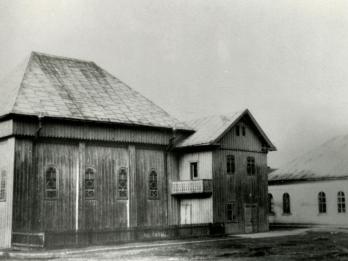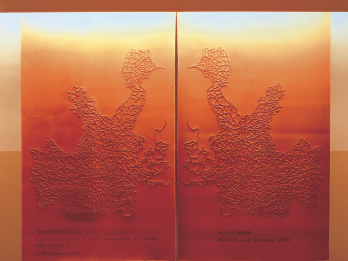Sheyris Yisroel (Remnant of Israel)
Menaḥem Man Amelander
1743
Chapter 34
The German holy community of Amsterdam was founded in the year 5396 [1635/6]. This I discovered in a few pages of a book written by Maharam Maarsen, one of the first German Jews in Amsterdam. He writes:
“We German Jews in the holy community of Amsterdam held a prayer service with a minyan for the first time on Rosh Hashanah and Yom Kippur in the year 5396. We read from two Torah scrolls borrowed from the Portuguese community. [ . . . ] We held the prayer service in Vlooienburg, in the home of Anshel Rad. He himself was the ḥazan. We did not hold services, apart from Rosh Hashanah and Yom Kippur. On Sukkot we once again attended the Portuguese Synagogue because we Ashkenazim did not have an etrog [citron]. After Sukkot we often held prayer services on the Sabbath. Six months later, some more Germans settled here. Then we began to rent a small room as a synagogue. And we appointed from our number two parnasim [elders] and two community leaders and as head of the rabbinic court we appointed R. Moses Weil. And Anshel Rad (mentioned above) was appointed as ḥazan and also as one of the community leaders; the second was Gumprech Levi. The two parnasim were Jacob Fekh Huvin and Michael; this was in the year 5396.
“We purchased the Muiderberg cemetery in the year 5399 [1639/40]. The first person to be buried there was Schwartz Meyer’s mother-in-law, and when we came with the body to the Hakkelaarsbrug they began ringing bells, as is customary at Christian burials. They thought that by doing so they did us and the dead person a great honor. Afterwards we put a stop to this and then they no longer did so.
“In the year 5408 [1648/9] many Polish Jews arrived, ships full of them, naked and barefoot, fleeing from the Khmel’nyts’kyi massacres in Poland, about which we have already written herein. The Portuguese Jews and some Christians took pity on them and helped them greatly. The Polish Jews rented a separate room for their prayer services because they wanted to maintain Polish customs. Therefore, they formed a separate community and had their own rabbi. This was the gaon R. Averli. Afterwards they appointed the great gaon R. Leib ben David. Later, when the German and Polish communities united, this R. Leib was appointed head of the rabbinic court of Rotterdam. He later left for the land of Israel and died on the 1st of Elul 5468 [1708]. In that year, the gaon R. Isaac ben Simeon Deckingen was appointed head of the rabbinic court and rabbi of the Ashkenazi community.
“In the year 5430 [1669/70] the Ashkenazi community received privileges from the ruler, his royal highness, to build a synagogue, beautiful and splendid according to their desire. They began work immediately. The first stone was laid on Thursday 11th of Iyar by Itzik Cohen, parnas of the Ashkenazi community. The Holy Ark was built from marble, paid for by R. Abraham Kosfeld. The synagogue was dedicated on the first day of Passover 5431 [1671]. The work took less than one year.
“The winter of the year 5437 was very long, longer than any other winter of memory. Shortly after Sukkot, the water began to freeze, and this went on almost until Passover. Then the ice melted during the long days, but froze again every night, until three days before Shavuot. For this reason, at Shavuot the trees were still as thin as they are in the month of Shevat. However, three days before Shavuot, there was suddenly a great heat wave and the snow and ice melted, as a result of which most of the country of Holland lay under water, as though it were a sea. Not only did the farmers in the villages suffer greatly, but also in Amsterdam the water flowed through the wide street and many cellars lay under water and much merchandise was lost. Likewise, many people and beasts drowned. Following this, the water also tore down a house and flowed through the New Market and made a great ditch up to the Waag [“House of Weights”]. And had the water not been stopped with sacks full of sand, the entire Waag would have been torn down. Great ships were washed up onto land. In many streets people used small boats to move between the houses. And in addition, the dam which was then close to the Portuguese synagogue would have been destroyed, but the town leaders sent straight away for craftsmen to strengthen the dam. Otherwise, God forbid, the Portuguese synagogue and our synagogue would have been flooded. But the Holy One, blessed be He, took mercy on the holy buildings, so may He continue to have mercy on all the nation of Israel.
“At that time, the great light, R. Meir Stern was appointed as head of the rabbinic court and rabbi of the holy community of Amsterdam. He was a man of great memory, the like of whom is not to be found, and proficient in Torah, Mishnah, Talmud, and the legal decisors and he was a great grammarian and expert in metaphysics and in kabbalah and the devotions of the Ari [Isaac Luria (1534–1572)], of blessed memory. He was previously head of the rabbinic court and rabbi of the holy community of Fulda. Following the exile of the Jews from Fulda he was appointed here and not long afterwards was made head of the yeshiva in the holy community of Kraków. After embarking on the journey from Amsterdam to Kraków, he died on the way and was buried in the holy community of Niederwesel in the year 5440.”
Other work by Amelander: Magishe minḥah (1726).
Credits
Published in: The Posen Library of Jewish Culture and Civilization, vol. 5.




